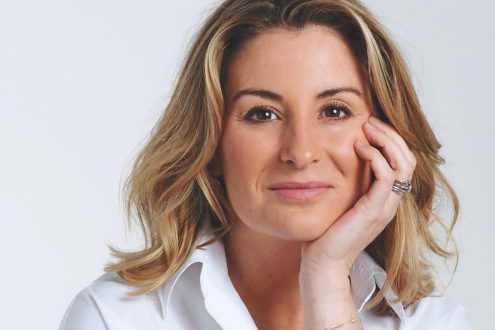Caring for someone with Alzheimer’s
Caring for someone with Alzheimer's can create an incredible bond between you both, as Rachel Garnett discovered when her mother-in-law was diagnosed...

When Rachel Garnett’s mother-in-law developed Alzheimer’s disease, she cared for her, and discovered a love she had never expected. Here, she explains how caring for someone with Alzheimer’s can create an incredible bond between you both...
Ten years ago, I was chatting in the kitchen to Brenda, my mother-in-law, while making coffee. We were talking about a trip I’d planned with my seven-year-old daughter, Alice, to go clothes shopping. ‘She has a definite idea of what she likes, so it could take some time,’ I said. ‘Steve and I went to so many shops the other day to buy him a pair of flares,’ said Brenda. ‘Mind you, it’s lovely seeing them pleased when they find what they want.’
The conversation was not all it seemed. The last time Steve – Brenda’s son and my husband – wore flares was as a child in the late 1970s. Brenda had Alzheimer’s, but it didn’t prevent her from teaching me so much about parenting, and from being a mother to me.
The first time I’d met her, I’d worried about her reaction. I was a single mum to Alice and my mother disproved, but Steve said Brenda would be thrilled to meet us and he was right. Her heart-warming welcome meant so much.
Receiving the diagnosis
Over lunch in a restaurant, Brenda and I realised that we had a lot in common, from a love of fashion to pigs – our favourite animal. I came away with a sense of calm, pleased that this lovely woman had entered my life. But I also recalled several times when Brenda asked what she’d ordered.
Devastatingly, she was diagnosed with Alzheimer’s 18 months later. Thankfully, the illness did not change Brenda’s loving personality, but she increasingly needed our support. We wanted to enable her to stay in her home, where she had lived with her late husband, Harry, and raised Steve and his sister, Lisa – and medical advice supported that.
Caring for my someone with Alzheimer’s
We got Brenda as much assistance as a cash-strapped council could offer. Lisa, my sister-in-law, visited regularly, but she lived 400 miles away, whereas Steve and I had a house on the same road. By this time, Steve and I had a son, Jamie, and I was on maternity leave, so we decided that Brenda, Jamie and I would spend every day together at Brenda’s house while Alice was at school. Steve would take over to be with Brenda after work.
Although I was happy to be Jamie’s mum, his birth triggered a sense of loss. My relationship with my own mother was distant. For the first weeks of the new routine, I felt very much the carer, doing housework and laundry and persuading Brenda to eat – her illness meant that she didn’t pay attention to hunger – as well as looking after Jamie.
Steve and I were tired with a new baby. I loved Brenda, but caring for someone with Alzheimer’s was hard work. Brenda was convinced it was Steve, not Alice, who was at school. I would constantly correct her, trying to help her see life in the present.

Learning from my mother-in-law’s memories
One morning, Alice was particularly slow getting ready for school and I shouted at her. I felt awful and needed to tell someone, so I told Brenda. I didn’t really expect a response, but I got the reply that 40-year-old Brenda, a working mum, would have given. She understood. She spoke about crying after telling Steve off – she was tired from work and he’d been playing up. ‘It was weeks ago, but I remember it like it was yesterday,’ she said.
She told me not to worry and patted my cheek. This incident was a game changer. Brenda’s wisdom as a mother was still there, so what if Alzheimer’s caused things to be jumbled up?
Days later, I told Brenda that Alice wasn’t enjoying school. Her teacher said she was fine, but I wasn’t so sure. Brenda told me that recently she’d demanded to see Steve’s head teacher because his dinner money was being stolen. She’d refused to leave until the teacher had seen her.
This forthrightness was out of character for Brenda but, note to self, you step out of your comfort zone for your children. I arranged to see Alice’s head teacher the following day.
Creating a bond with someone who has Alzheimer’s
Brenda was proud of her children, but she was also proud of her grandchildren and me. She would tell me that I was pretty, clever, lovely and kind. I wasn’t used to compliments from a maternal figure and, at first, I laughed them off. But she would repeat them again and again and, after a while, they started to sink in and I began to accept them.
Towards the end of my maternity leave, a medical professional came to assess Brenda. She was meant to be naming the current prime minister but, instead, she listed my positive qualities, and I felt so pleased.
For me, growing up had been a serious experience, but Steve’s childhood was different. He had many funny stories about Harry and Brenda as parents, which he teased her about. My favourite was when they went to a Victorian fancy-dress party. They left looking prim in period dress, but came back later in a black cab, roaring with laughter, having imbibed more wine than any self-respecting Victorian!

Using photos to prompt memories
Photos helped Brenda too. Steve had read that they were useful for prompting memory when caring for someone with Alzheimer’s, so Brenda and I would flick through them together, often at mealtimes to take the pressure off. With Brenda, I became happily involved in joyful reminiscences of Steve’s carefree childhood. They offered an alternative template for family life.
Alice discovered a photo of a tanned Steve in jazzy Speedos taken in Yugoslavia in the 1980s. Not only was it typical of the enterprising Harry and Brenda that they’d managed to holiday in the former Eastern bloc, but it was placed alongside formal pictures of a family wedding in an album. It had clearly been done by Brenda or Harry as a joke to make the family laugh.
Alice occasionally mentions it as one of the funniest things she’s seen and Jamie likes to hear how he was part of it. Practically, using photographs while caring for someone with Alzheimer’s taught me that family photos are too important to be left in an online cloud, so now I fill albums.
Finding time to be ‘mother and daughter’
Since having Alice, I’d been keen on mother and daughter time. When I saw women my age enjoying moments with their mothers, getting their nails done or having a cocktail together, I’d felt sad. I didn’t have this relationship with my mum, but I had it with Brenda.
Alzheimer’s made it trickier for Brenda, who took pride in her appearance, to get dressed. With Jamie on my lap, Brenda and I would browse online for clothes that weren’t fiddly with buttons or zips and were easier to put on and take off. We developed her new look, with soft-knit joggers and scoop-neck tops. We looked at new clothes for me too.
The importance of routine when caring for someone with Alzheimer’s
Going to the hairdresser was an important part of Brenda’s life. She had gone every week for the past 30 years. She liked getting her hair done, and taking time out for herself had always been a ritual, the way swimming was for me. It was a place where she felt comfortable and we wanted to keep that routine for her.
It took most of the day to prepare as Brenda would insist that Jamie and I got ready first – that I had been to the loo, had my shoes and coat on and that Jamie was wrapped up and in his car seat. At first, I found it frustrating, but, once I realised that she was in mum mode, it made sense.
It became a weekly outing that we all looked forward to. It was also social time for Jamie, who was cooed over by people who had known Brenda for years. One week, I needed to push Brenda’s bottom into the car and we both giggled. It occurred to me that I wouldn’t have felt comfortable doing that to my mother.
I realised how precious this easy, loving bond with my mother-in-law was. Two years after our unique time together, Brenda went into a care home and she died four years ago. We miss her greatly. I feel extremely lucky to have experienced such a relationship as a daughter-in-law.

What I learnt from caring for someone with Alzheimer’s
You may not have a Brenda in your life, but here is some of the wisdom I learnt from caring for someone with Alzheimer’s…
1. Don’t try and do it all
Brenda was a busy working mother but, even in the sexist 1970s, she and Harry would share household chores and she would supplement her excellent cooking with ready meals.
2. Be kind to others
Brenda never prejudged people. Her instinct was to make everyone feel welcome. This was one of the things I loved most about her.
3. Value close friendships
Brenda and her best friend spoke every day. It may have only been a five-minute call to catch upon each other’s day but it meant so much to both of them. They supported each other from childhood to Brenda’s death.
4. Recognise your achievements
Brenda had worked for the BBC and she would talk with pride about her job. She ensured people gave themselves credit for what they had achieved.
5. Find the positives in your situation
Brenda always saw the joy in life and this ability never left her, which comforts me. During her last summer, when Alzheimer’s prevented her from remembering our names and even walking was difficult, we would drive to a local lavender field. Brenda’s pleasure at breathing in the scent, surrounded by those who loved her, was obvious.










